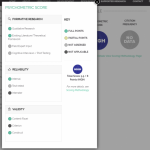Utilizing the #MeToo Movement to Strengthen Advocacy for Comprehensive and Scalable Adolescent Sexual and Reproductive Health Education in the U.S. & Globally
Sexual violence is a threat to the health and well-being of human beings globally, and in the U.S. evidence shows that it disproportionately effects women and LBTQ+ individuals 1-3.
Norms and behaviors that perpetuate sexual violence in human society must be addressed.
What is one way to do this? Evidence-based education at an ideal intervention point, adolescence (ages 13-19), could be effective. As a time of innate fluidity (cognitively, behaviorally, & socially), adolescence may be an ideal period target harmful norms and behaviors and try to change them. Early, Consistent, and Comprehensive Sexuality Education (CSE), that promotes healthy sexual behavior (i.e. consent, communication, and respect) and directly addresses behaviors and norms that perpetuate sexual violence, should become the standard for sex education in the U.S. and globally.
Part of advocating for standardized sex education should be to agree on what enables good sexual and reproductive health (SRH), so that these facilitators can be targeted as well.
Good SRH (as defined by the United Nations) “is a state of complete physical, mental and social well-being in all matters relating to the reproductive system”, and may be facilitated at the individual level by:
- Knowledge/access
- Knowledge of and access to modern contraception. Specifically, knowledge of how to obtain and effectively use contraception
- Knowledge of biological sexual and reproductive health, including and understanding of puberty, the menstrual cycle, how to prevent STIs, and health effects of early pregnancy and childbirth
- Knowledge of the human right to health and safety
2. Autonomy & empowerment
- Autonomy and ability to use contraception correctly and consistently
- Empowerment to demand and work towards achieving good SRH
3. Safety
- Safety from sexual and reproductive coercion and gender or sexual orientation-based violence
4. Skills
- Effective communication skills, inclusive of ability to obtain true consent, communicate, non-consent, and communicate and process feelings related to SRH in health way
The global climate of the #MeToo movement provides an excellent opportunity to fortify and reaffirm a commitment to advocating for sex education that addresses sexual violence and to work towards creating organized, standardized and scalable education programs that facilitate good SRH. Educators, researchers, health professionals, advocates, exist around sex education, globally, nationally, and at the state-level.
Sex Education Policy Guidelines, at a glance
- Global
- United Nations (UNESCO, UNFPO, WHO)
- International technique guidance on sexuality education, an evidence-informed approach published in 2018, advocates for the use of VSE at the global level.
2. National (U.S.)
According to a report published by the Guttamacher Institute (updated May 1, 2018), 24 States and the District of Columbia mandate sex education, 27 states mandate that sex and HIV education programs meet general requirements, and only 13 states require that the information provided is medically accurate.
- Government
- U.S. Department of Health and Human Services
- Sponsored an independent, systematic review of teen pregnancy prevention programs, listed here.
- U.S. Department of Health and Human Services
- Centers for Disease Control and Prevention (CDC)
- Developing a Scope and Sequence for Sexual Health Education, published in 2016, outlines a strategy for developing effective sexual education curriculums that align with the National Health Education Standards and prioritize state and local SRH high priorities.
- 2016 School Health Profiles Report, published in 2016, outlines a strategy for developing effective sexual education curriculums that align the National Health Education Standards and prioritize state and local SRH high priorities.
- Non-government
- Future of Sex Education (FoSE)
- National Sexuality Education Standards, published 2011, aimed to provide clear guidance on minimum core content for sex education.
- Sexuality information and Education Council of the United States (SIECUS)
- Guidelines for Comprehensive Sexuality Education: Kindergarten-12th Grade, third edition, published 2004, described the CSE model
- Future of Sex Education (FoSE)
3. State (California)
- The state of California enacted the California Healthy Youth Act in January 2016, which requires school districts to implement inclusive and comprehensive sex education in grades 7-12, and provides guidance on appropriate curriculum should a school district elect to teach sex education in earlier grades.
Authored by: Emma Jackson
References:
- Black, M.C., Basile, K.C., Breidig, M.J., Smith, S.G., Walters, M.L., Merrick, M.T., Chen, J., & Stevens, M.R. (2011). The National Intimate Partner and Sexual Violence Survey (NISVS): 2010 Summary Report. Atlanta, GA: National Center for Injury Prevention and Control, Centers for Disease Control and Prevention.
- Walters ML, Chen J, Breidig MJ, The National Intimate Partner and Sexual Violence Survey (NISVS): 2010 Findings on Victimization by Sexual Orientation. Atlanta, GA: National Center for Injury Prevention and Control, Centers for Disease Control and Prevention; 2013.
- Strozer RL. Violence against transgender people: A review of United States data. Aggression and Violent Behavior. 2009; 14(3): 170-179.




